Hebe speciosa



Woody
Stems and branches with a woody texture commonly associated with shrubs or perennials.
Low Bun Shape
A plant forming a low mound, rounded shape.This shrub has upright spreading grey brown stems that form a compact to open rounded habit. It has large, glossy green elliptical leaves and the tube-shaped violet-purple flowers appear in a upright raceme from late spring to summer.
Hebe speciosa is naturally found on both islands of New Zealand growing in coastal regions appearing on cliffs and adjoining hillsides. It prefers a well drained poor to moderately fertile moist sandy soils that are tending neutral with a pH range from 7.0 to 8.5. It grows in an open to exposed sunny position and is frost, drought and salt tolerant.
The Showy Hebe is grown for its flowers, glossy foliage and its rounded bushy habit. It is planted in parks and gardens along borders as a filler pant or as a specimen in a seaside garden. It is also grown in large pots and tubs and establishes in 2 years. It requires little maintenance and may be trimmed as hedge. It is suitable for coastal regions and once established it has a low water requirement (Scale: 1-drop from 3), responding to mulch and an occasional deep watering during dry periods, particularly for young plants.
UK hardiness zone H2
Climate zones 14 - 24
Zone 9-10
Hebe (HEE-bee) speciosa (spee-see-O-sa)
'Hebe': ancient Greek goddess of youth; 'la seduisante': from French, the seductress
Cultivars
'La Seduisomte' syn. 'Ruddigore'
This upright rounded shrub has narrow thick glossy green leaves and has violet-purple flowers from late spring to early autumn.
'Variegata'
This shrub is similar to the species got produces glossy green leaves with a creamy white margin.
Scrophulariaceae (skrof-yoo-larr-ee-AY-see-ee)
Figwort and Foxglove Family
This family of dicotyledon perennial herbs, annuals and shrubs rarely trees, epiphytes or aquatic.
Distribution
This family of plants are found throughout the world in a wide range of habitats and are commonly found in open grassy regions but rarely in tropical forests.
Diagnostic Features
The leaves are simple or pinnatisect and are arranged alternately or oppositely, rarely whorled with an entire to lobed margin.
The zygomorphic flowers are bisexual or unisexual and are arranged in a racemes, thyrse or are solitary. There are 4 - 5 free or fused sepals and 4 - 5 lobed corolla that is normally 2 ipped with the upper lip divided into 2 lobes and the lower divided into 3-lobes that may be spurred.
There are 4 - 5 stamens that are inserted in the corolla tube and the ovary are superior with 2 free and a terminal style. It contains 2 locules with 2 to many ovules.
The fruit is normally a capsule rarely a berry and contains numerous seeds that may be winged.
Note:
Plants in this family are of major importance to the horticulture industry as ornamentals.
This plant tolerates between USDA zones 9a to 10a and grows to 1.5 m (5 ft)
Fahrenheit 20º to 30º F
These temperatures represent the lowest average
Celsius -3.9º to -1.1º C
Attention
All photographs and data are covered by copyright. Apart from any fair dealing for the purpose of private study, research, reference or review, as permitted under the Copyright Act, no part may be reproduced by any means with out written permission. All inquiries should be addressed to plantfile.com attention Peter Kirkland.

Simple
The leaf that is not divided.
Elliptical
A leaf that tapers equally at both ends. Broadest at the middle.
Decussate
Arranged in pairs of opposite members, each pair turned at right angles to the succeeding pair.
Entire
A leaf margin with no irregularities (smooth).
Tubulate
A flower that forms a tube shape.
Raceme
An inflorescence forming along a central stem of indefinite length with flowers having there own stems.| Jan | Feb | Mar | Apr | May | Jun |
| Jul | Aug | Sep | Oct | Nov | Dec |
The violet purple tubulate flowers have 4 perianth segments and are arranged in an axillary raceme that is up to 70 mm (2 2/3 in) long and appear appearing from late spring to summer.

Capsule
A dried dehiscent fruit, with an enclosing membrane normally containing may seeds."The Showy Hebe is grown for its flowers, glossy foliage and its rounded bushy habit. It is planted in parks and gardens along borders as a filler pant or as a specimen in a seaside garden. It is also grown in large pots and tubs and establishes in 2 years. It requires little maintenance and may be trimmed as hedge.
Note:
General information
Hebe requires an annual light prune to maintain a compact habit. If the plant becomes leggy a hard prune may result in dieback of the plant.
Hebe grows and produces more flowers in full sun, but will tolerate some shade. They are generally pH adaptable preferring and organic rich moist soil but care must be taken not to allow the roots to dry out. They also tolerate cold conditions and a widely cultivated in the UK and parts of the USA.
Sow fresh seeds during autumn and place in a protected environment to germinate. Seedling variation occurs regularly and seeds are prone to fungal attack. Take semi-hardwood cuttings of non-flowering shoots from late summer to early autumn and placed in a protected environment with bottom heat.
Propagation by Seed (General)
Germination
In order for a seed to germinate it must fulfil three conditions.
1. The embryo must be alive (a viable seed).
2. The seed must have no dormancy-inducing physiological, physical or chemical barrier to germination; also the seed must be nondormant.
3. The seed must have the appropriate environmental requirements, water, temperature and oxygen.
The interaction between these requirements and dormancy is complex and may lead to different environmental requirements that avoid the dormancy of a seed.
Sowing Seeds in Containers
There are two general methods for germinating seeds.
Seeds in a flat or germinating bed, through which seedlings are pricked-out then, transplanted into another flat with wider spacing or directly to an individual pot.
2. Sowing seeds by placing them in to flats with the appropriate spacing or into individual pots.
This method is normally carried out with medium to large seeds such as woody plants and plants that are difficult to transplant.
Seedling production normally occurs in a greenhouse / glasshouse, cold frames and on hot beds.
Method of Seed Sowing
Fine seed is sown in pots or flats that are no deeper than 70 to 80 mm. using a sterilised well-drained media (soil). Fill the container to 20 mm from the top and sprinkle sieved peat to 3 mm depth.
Press the media down level and firm with a piece of timber and then thoroughly moisten.
Mix the fine seed with washed sand and then sow thinly on the surface. These may be lightly covered with sand.
Larger seeds may be covered with media or a hole is dibbled and the seed is placed in the media.
Watering Methods
For watering you may either mist the containers from above or place the container in tepid water and allow the water to raise through the pot to the surface of the media, then drain away and do not fill to the top of the container.
Place a piece of glass over the pot and store in a protected warm environment (glasshouse).
Seeds germinate best in darkness so shade the containers if in direct sunlight.
After the seedlings have sprouted remove the glass and ease the seedlings into direct light.
When the seedlings are large enough prick them out and transplant into larger containers then place them in a shade house to harden off.
Many seeds have different methods of seed preparation for germination such as nicking or cutting the seed coat to allow water penetration, also placing seeds in hot water and allowing it to cool off.
This is particularly important as it is softening the seed coat.
Asexual Propagation (Cuttings general)
Propagation from cuttings is possible because every cell of a plant containers the genetic information to create an entire plant.
1. Reproduction occurs through the formation of adventitious roots and shoots.
2. The uniting of vegetative parts with budding and grafting.
3. Taking stem cuttings and layering is possible due to the development of adventitious roots
4. Root cuttings can form new shoots then it is possible to join roots and shoots to form a new plant.
5. A new plant may be formed from a single cell in an aseptic culture system, (cloning).
It is important to propagate vegetatively as this form of cloning retains the unique characteristics of the cultivars or where particular aspects of a plant may be lost if propagated by seed.
Equipment Required for Taking Cuttings
1. A sharp knife that is not too large or a razor mounted in a handle.
2. Good pair of sharp secateurs that is clean.
3. A dibbler to make a hole in the media and allow the cutting to be placed in.
4. Propagation structures that are either a timber frame with glass or polyethylene cover or a glasshouse.
The object of the structure is to create an environment where the temperature and humidity can be controlled. This can be achieved with a simple cover over a pot with a wire frame and plastic.
This stops the draughts and maintains humidity.
5. A hotbed is a useful item as many plants root more quickly if the media is slightly warmer.
Bottom heat is obtained from thermostatically controlled heating cables that are running under the media.
6. Misting systems are of great benefit to cuttings as the regulated fogging with water inhibits the cuttings from drying out and as a result the cuttings may be grown in full sun.
This results in faster root development that is less subject to diseases by fungi and bacteria.
7. Rooting mediums
The rooting medium must be well drained, sand may be used as long as it is thoroughly washed and leached of all salts. It is very well drained and it is excellent for cutting that root up quickly. Equal parts of sand and peat moss have good results for cuttings, which are left for a period of time to allow the roots to form.
Vermiculite and perlite are also used as a well-drained rooting media but has the same disadvantage as sand having no nutrients. The cuttings must be potted up as soon as the roots developed, or a light application of liquid fertiliser can be applied.
Types of Cuttings
Stem cuttings
These are the main types of cuttings.
1. Softwood cuttings
These cuttings are taken from young growth on side shoots and tip growth.
2. Semi hardwood cuttings
These cuttings are taken from wood that is firmer and semi ripe usually during mid summer.
3. Hardwood cuttings
These cuttings are taken from mature wood normally towards the end of the season.
4. Root cuttings
Cut sections of roots to obtain new plants during late winter to early spring.
5. Leaf cuttings
Cut the leaf blade in order to obtain new plants during the growing period of the plant.
Cutting preparation
Hardwood cuttings
When taking hardwood cuttings remove the leaves and in semi hardwood reduce the number of leaves by half. Cut the wood straight across just below a node or joint. Hardwood cuttings are normally between 100 to 760 mm long and may have either a heel of the older wood attached to the base, or a short section of the older wood at the base. These cuttings are prepared during the dormant season from late autumn to early spring and are made up from previous season's growth.
This type of cutting is used for woody deciduous plants such as Crepe Myrtle, Rose rootstocks and some fruit trees.
The cuttings should be healthy wood with ample supply of stored food as to nourish developing roots, shoots and placed in the rooting media with the aid of a dibbler stick.
Softwood cuttings
The cuttings for softwood should be 60 to 130 mm long and be of material with enough substance as to not deteriorate before the new roots appear. Cut below a node and retain the leaves on the upper portion. Place in a well-drained media and maintain a high humidity.
Soaking the cuttings and leaving them standing in water for long periods is undesirable.
Herbaceous cuttings
These cuttings are taken from succulent plants such as Geraniums and Coleus. The cutting should be 70 to 130 mm long with leaves retained on the upper end. As in softwood cuttings these require an environment of high humidity. Some fleshy cuttings ooze sap and may require a drying period for a few hours before being placed in the rooting media.
Leaf cutting
In these cuttings a leaf blade and petiole or part off is used to raise a new plant. The original leaf doses not become a part of the new plant as roots and shoots appear from the base of the leaf. In some cases roots appear from the severed veins.
Leaf-Bud cuttings
These cuttings incorporate a leaf, petiole and a small piece of the stem. These cuttings are an advantage where the plant uses the axillary bud at the base of the petiole for new shoot growth and maximises available propagation material, as each node will produce a new plant.
As in softwood cuttings these require an environment with high humidity and warmth.
Root cuttings
These cuttings are best taken from younger plants during late winter to early spring prior the new season's growth unless the dormant period is during summer.
Trim the roots as they are dug up, to maintain polarity cut strength at the crown end and a slanted cut at the distal end (away from the crown).
Root cuttings of small plants are placed in flats in lengths of 20 to 50 mm and laying horizontally on the surface of the soil. These may be lightly covered with sieved sand or media, watered and then placing a piece of glass or polyethylene over the container till roots / shoots appear.
Fleshy root cuttings
These cuttings should be 50 to 75 mm long and placed vertically in a well-drained sand media.
Keep the polarity correct and when the roots develop transplant the cuttings into a separate container.
Large root cuttings
These cuttings are 50 to 150 mm long are tied up in bundles and placed in boxes of damp sand, sawdust or peat for about three weeks at a temperature of 4.5º C. When taken out they should be planted in a prepared bed 50 to 80 mm apart with the tops of the cuttings level with or just below the soil level.
PEST
NAME
Aphids
Various Aphid Species
ORDER
Hemiptera
FAMILY
Aphididae
Description of the Pest
The common name varies and aphids may be referred to as black fly, greenfly, ant cows or plant lice.
These small insects have soft globular body that is from 1mm to 8mm long and vary in colour from green, yellow, black and pink, with the winged forms being elongated. Both adult and nymphs, have piercing and sucking mouthparts.
Aphids are found on buds, flowers, or leaves and stems, preferring soft new growth. On older leaves the aphids are found in protected positions, such as under the leaf. Certain species of aphids form galls as they suck sap and may be found on the roots of the plant. (E.g. Woolly aphids and Black peach aphids)
Most aphids possess a pair of characteristic tubular projections, known as cornicles; these secrete a pheromone and a waxy fluid, which is thought to protect them from some of their predacious enemies.
White exoskeletons, honey dew and sooty mould indicate the presence of Aphids
Balsam Twig Aphid (Mindarus abietinus) is greenish and covered in a white wax and is normally found on the young shoots of conifers bending and killing the needles. It is found on Abies and Picea species.
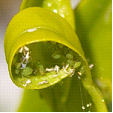 Aphid and their exoskeletons
Aphid and their exoskeletons 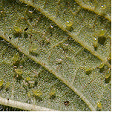 on underside of a leaf
on underside of a leaf
Black Citrus Aphid (Toxoptera aurantii) has a soft plump green body and the black coloured adults may or may not be winged. They feed in groups, curling leaves and producing honeydew attracting sooty mould.
Green Peach Aphid (Myzus persicae) is a soft plump green insect up to 0.2mm long and may be wingless. The nymphs are yellowish green and are responsible for spreading viruses in Dianthus species.
Spruce Gall Aphid (Chermes abietis) form cone shaped galls up to 12mm long resulting from the feeding. The wingless female adult lays eggs on the stems and the immature females overwinter on bud scales. Large infestation will weaken trees such as Picea abies and Pseudotsuga menziesii.
Tulip Bulb Aphid (Anuraphis tulipae) is small, waxy grey coloured and infests the underside of the bulb scales or rhizomes. They occur in the ground or on above ground parts and during storage.
Life Cycle
These insects have a Hemimetabolous life cycle, i.e. The nymphs resemble the adults.
During spring all eggs produced hatch as female nymphs. Adult Aphids are capable reproducing without fertilisation. The males are only produced in some species as the weather cools down, and the day length shortens.
Aphids are capable of giving birth to living young and large populations build up quickly during summer. Over crowding causes the aphids to become smaller, less fertile and produce more winged forms that can migrate to other host plants.
There are many different types of aphids and the life cycle varies from warm to cold climates.
Typical life cycles

Distribution of the Pest
World wide
Period of Activity
In warm climates they are seen throughout the year, but aphids dislike hot dry or cold conditions and heavy rain will decrease the population. In cold areas aphid eggs are laid around a bud base or other protected areas of the plant during autumn and emerge as nymphs during spring, feeding on the new growth.
Numbers build up quickly in the warmer months of the year. Some species feed during winter on Sow thistles.
Susceptible Plants
There is a wide range of plants attacked, from roses to vegetables, shrubs and trees. Certain aphids attack a specific genus while others have a wide range of host plants. Many are capable of transmitting plant virus diseases.
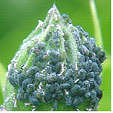 Adults and nymphs feeding
Adults and nymphs feeding 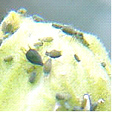 A colony of aphids
A colony of aphids
Acer species are attacked by several aphids including the Norway Maple Aphid (Periphyllus lyropictus) which is a greenish with brown markings and secret honeydew, preferring Acer platanoides. Other aphids include (Drepanaphis acerifolia) and (Periphyllus aceris) which are commonly found on the underside of leaves.
Acer species are also attacked by the Woolly Maple Aphid (Phenacoccus acericola) which covers the undersides of the leaves with a cotton-like mass
Alnus species are infested with the Alder Blight Aphid (Prociphilus tessellates) which is blue-black adult that forms woolly masses on the down-turned leaves. The nymphs overwinter in bark crevices.
Aquilegia species are attacked by several aphids including (Pergandeidia trirhoda) which is a small, flat cream coloured insect that is found on young branches and the underside of leaves.
Betula species may be attacked by the European Birch Aphid (Euceraphis betulae) which is small and yellowish or the Common Birch Aphid (Calaphis betulaecolens) which is large and green producing ample honeydew for sooty mold to grow on.
Callistephus species may be attacked by the Corn Root Aphid (Anuraphis maidi-radicis) causing the plant to become stunted, the leaves wilt and turn yellow. The aphids feed on the roots producing honeydew and are dispersed to other host by ants. It is also attacked by the Potato Aphid (Macrosiphum solanifolii).
Carya species are attacked by Gall Aphids (Phylloxera caryaecaulis) which is found on the leaves, twigs and stems forming galls and turning them black.
Chaenomeles and Gladiolus species, new growth and leaves become infested with the aphid (Aphis Gossypii)
Cupressus macrocarpa may become infested with the Cypress Aphid (Siphonartrophia cupressi).
Cyclamen species are attacked by the aphid (Myzus circumflexus) and (Aphis gossypii) which can infest healthy plants.
Dendranthema, Dianthus and Crocus species are attacked by several types of aphid including the Green Peach Aphid (Myzus persicae) and the Chrysanthemum Aphid (Macrosiphoniella sanborni).
Hibiscus species are attacked by the aphids (Aphis craccivora) and (Aphis gossypii), both congregate towards the branch tips and may cause leaf curl. Normally only seen in sub-tropical climates.
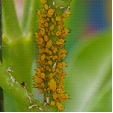 Aphids on a stem
Aphids on a stem 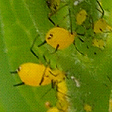 Mandevilla species
Mandevilla species
Larix species is attacked by the Woolly Larch Aphid (Adelges strobilobius). The winged adults deposit eggs at the base of the needles during spring and white woolly areas appear attached to the needles where the adult aphids feed. The young aphids overwinter in the crevices of the bark.
Mandevilla species is attacked by aphids that congregate towards the branch tips and may cause leaf curl.
Pinus species is attacked by several species of aphid including Pine Bark Aphid (Pineus strobi), Pine leaf Aphid (Pineus pinifoliae) and the White Pine Aphid (Cinara strobi).
Primula species are attacked by four species of aphid including foxglove, and green peach aphid.
Rudbeckia, Delphinium, Chrysanthemum and Helianthus species are attacked by a bright red aphid (Macrosiphum rudbeckiae).
Sorbus aucuparia is affected by the Rosy Apple and Woolly Apple aphid which attacked the foliage and young shoots.
Spiraea species are attacked by the Aphid (Aphis spiraecola) which feeds on the young shoots and flowers.
Tropaeolum species are attacked by the Black Bean Aphid (Aphis fabae), which is found in large numbers on the underside of the leaves, turning them yellow and causing them to wilt then die.
Tulipa, Iris, Freesia, Gladiolus and Zephyranthes species are infested with the Tulip Bulb Aphid.
Ulmus species are infected by two types the Woolly Apple Aphid (Eriosoma lanigerum), which curls and kills young terminal leaves and the Elm Leaf-Curl Aphid (Eriosoma ulmi) which occasionally attacks the trees.
Viburnum species are attacked by the Snowball Aphid (Anuraphis viburnicola). This aphid congregates at the end of the branches causing the leaves to curl and become deformed under which they hide.
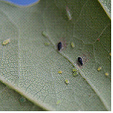 Aphids on Quercus robur
Aphids on Quercus robur
Damage Caused
Buds that have been attacked may not open, leaves and twigs become twisted or distorted and wilt. The aphids also produce honeydew, which is sticky and attracts sooty mould (fungus). This fungus forms a thick layer over the leaf, fruit or stems reducing the plants photosynthesis capability. The sooty mould spoils the plants appearance and its fruit, as does the insects white exoskeletons.
Control
Cultural Control
Aphids may be removed from a plant by hosing them off with water (limited success) or applying soapy water to aphids.. Another organic sprays can be efficient in controlling aphids. Aphids may also be removed physically by hand for small colonies on spine less plants. Species that live under ground are difficult to control but cultivation of the surrounding soil may help in controlling the infestation. (limited mainly to annual or commercial crops)
Reflective mulch around the plants also reduces numbers by repelling the insect this material is available commercially. (Reflective mulches are mainly used in market gardens for avoiding the Green peach Aphids) Resistant rootstocks are available to avoid some root feeding aphid of commercial plants, e.g. Vines and fruit trees
Biological control
Aphids are attacked by several insects includes parasitic wasps or predators such as ladybirds/ lady beetles, hover flies, lacewings, spiders.
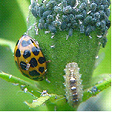
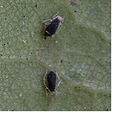 Parasitised aphids
Parasitised aphids
Chemical Control
Aphids may be controlled by spraying with a contact or systemic insecticide. The type of application used will depend on the plant is being attacked.
Aphids can be suffocated and therefore controlled with the use of e.g. White oil, Pest oil, Soapy water from soap such as Lux Flakes ®
Note
It is your responsibility by law to read & follow the directions on the label of any pesticide
Monitoring
Aphid are attracted by yellow colour and traps such as boards painted yellow and covered in glue or sticky substance will attract and trap the insects. There is also a commercially sticky yellow tape that can be attached to susceptible plants
Amendments by B. Sonsie Dip Hort Sc Burnley
DISEASE
NAME
Leaf Spot (General)
Various Leaf Spot Species
Description
There is a wide variety of fungal leaf spots that infect perennials, shrub and trees. Some are specific to the host while others can affect a range of plants.
Symptoms
Generally light brown to purplish or blackish spots appear on the leaf and form concentric rings of fruiting bodies. The spots may leave holes, perforating the leaf or expand with pale green to yellowish margins and when the holes merge the leaf normally dies. There are many different types of leaf spot, some are discussed below.
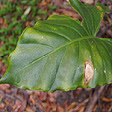 Alocasia species
Alocasia species 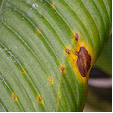
Alternaria Leaf Spot (Alternaria nelumbii) forms a small reddish brown spots that are boarded in light green, and as they develop in size the leaf curls and dies from the margin inwards. Normally occurs on Nelumbo species (water lilies).
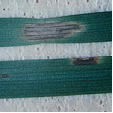 Helminthosporium Disease
Helminthosporium Disease
Helminthosporium Disease (Bipolris species), (Drechslera species) and (Exserophilum species) are responsible for several leaf spots that occur on all Turf Grass species. Generally they form black or white spots that may be faded and produce masses of spores in the thatch during late summer, under humid conditions. The life cycle is short and when conditions are favourable spores are splashed onto the foliage from the thatch, causing wide spread infection. Cynodon dactylon (common couch) is most susceptible and found in bowling or golf greens where it is a serious problem.
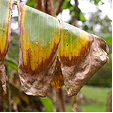 Banana Leaf Spot
Banana Leaf Spot 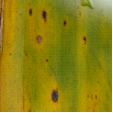
Banana Leaf Spot (Mycosphaerella musicola) is found on many species of banana causing pale yellow streaks on the young leaves to turn brown with dark spots. The leaf then becomes dried, brown and dead commencing from the margins, eventually the leaf dies. Control requires removal of infected foliage or the spraying of a fungicide and fungicides should not be used during the fruiting period.
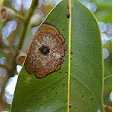
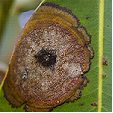 Lophostemon confertus (Brush Box)
Lophostemon confertus (Brush Box)
Leaf Spot on Brush Box (Elsinoe species). This is a casual fungus that attacks the epidermal layer of the leaf, forming circular spots that are up to 25mm across and are often restricted by the main vein. These spots are a dull yellowish brown but can also have purplish patterns. A leaf may have more than one spot develop on its surface and normally appears on scattered leaves throughout the tree. This doesn't affect the vigour of Lophostemon confertus.
Palm Leaf-scab (Graphiola phoeicis) appears as yellow spots and develop into scabs or warts that are outwards hard and dark but with a soft centre with powdery yellowish brown spores. The infected leaves eventually die.
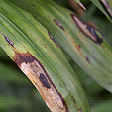 Palm Leaf Spot, Chamaedorea elegans
Palm Leaf Spot, Chamaedorea elegans
Palm Leaf Spot (Pestaloptiopsis species) appears as a small spot with a dark centre on the leaves and affects palms that are growing in shaded humid positions and normally control is not required, though infected fronds should be removed.
Source and Dispersal
Infection source is other contaminated plants and the spores are spread by wind or by splashing water. The fruiting bodies are black spots that appear on the damaged tissue releasing spores.
Favoured Conditions
This fungus prefers a warm humid environment and leafy plants with soft new growth, particularly if they are crowded.
Affected Plants
There are many ornamental and native plants that are hosts to a wide range of fungal leaf spots. Some specific ones are listed below. Plants such as Cornus or Paeonia species are infected by a large variety of leaf spots, while other plants attract a specific leaf spot.
Generally a healthy plant can tolerate fungal leaf spot attack, though it may make the plant look unsightly. In trees and shrubs it is difficult to control and generally not necessary, but in perennials and annuals control may be necessary in order to save the plant.
Acalypha and Arctotis species are infected by up to three leaf spots including (Cercospora acalyphae) and (Ramularia acalyphae) that rarely require control.
Acer species are infected by Purple Eye (Phyllosticta minima) which forms spots with brownish centres and purplish margins causing the death of the leaves.
Acer species are also infected by Tar Spot (Rhytisma acerinum) which forms round black spots that have yellow margins. Not normally seen on cultivated trees, but seen in forests.
Adiantum, Asplenium, Blechnum, Cyathea, Davallia, Nephrolepis, Platycerium, Polypodium and Pteris species are infected by the leaf spot (Pseudocercopora species) which forms circular brown spots on the fronds and heavy infection can defoliate a plant.
Aesculus species are occasionally infected with the leaf spot (Septoria hippocastani) which forms small brown spots.
Agave species are susceptible to the leaf spot (Coniothyrium concentricum), which appear as greyish spots up to 20mm (1in) across with concentric rings and black fruiting bodies. Affected leaves are destroyed as the infection spreads.
Albizia julibrissin is susceptible to the fungal leaf spot (gloeosporium aletridis), which does not normally require control.
Amelanchler, Chaenomeles, Crataegus and Rhaphiolepis species Mespilus germanica are infected by the leaf spot (Fabraea maculata) which may cause considerable damage during wet periods.
Aquilegia species can be infected by three types of Leaf Spot including (Ascochyta aquilegiae), (Cercospora aquilegiae) and (Septoria aquilegiae), normally appearing during humid conditions forming spots on the leaves.
Arbutus species are infected by two leaf spots (Septoria Unedonis) which produces small brown spots on the leaves and (Elsinoe mattirolianum).
Arctostaphylos manzanita is infected by the leave spot (Cryptostictis arbuti) which damages leaves but is not normally detrimental to the shrub.
Aspidistra species are infected by the leaf spot (Colletotrichum omnivorum) causing whitish spots on the leaves and petiole.
Aster species are infected by many leaf spots including (Alternaria species), (Cercosporella cana), ( Ovularia asteris) and (Septoria asteris).
Aucuba species are infected by several leaf spots, usually as a secondary infection after aphid attack. These include (Phyllosticta aucubae) and (Phyllostica aucubae).
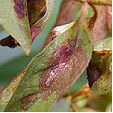
 Azalea
Azalea
Azalea (Rhododendron species) are susceptible to Leaf Scorch (Septoria azalea). This fungal disease forms reddish- brown spots which expand and engulf the leaf, with fruiting bodies appearing in the centre. Infected leaves die, then fall and the branchlets wilt. This problem is more serious during wet periods and may require control using a fungicide.
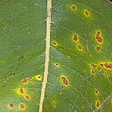 Banksia robur
Banksia robur
Banksia species are infected by several leaf spots causing chlorotic areas that have brown centres and is not normally a major problem for the plant.
Betula species may be infected by the Leaf Spots (Gloeosporium betularum) that forms brown spots with darker margins and (Cylindrosporium betulae) that also forms brown spots with faded indefinite margins.
Bougainvillea species are infected by the leaf spot (Cercosporidium bougainvilleae) which forms rounded spots with dark margins that yellowish ting. Infected leaves die and fall from the plant.
Calendula species are infected by the Leaf Spot (Cercospora calendulae) which rapidly infects the plant spotting the leaves and killing the plant.
Callicarpa species may be infected by the leaf spot (Atractilina callicarpae) forming irregular brownish spot or (Cercospora callicarpae) which can defoliate the plant in subtropical climates.
Campsis species may be infected by several fungal leaf spots including (Phyllosticta tecomae), (Septoria tecomae) and (Cercospora duplicata).
Carpinus species are infected by the leaf spots (Gloeosporium robergei), (Gnomoniella fimbriata) and (Septoria carpinea), all are minor infections not normally requiring control.
Carya species are infected by several leaf spots including (Gnomonia caryae) that infects leaves with irregular reddish spots on the upper surface with corresponding brown spore producing spots on the underside. It also has a secondary spore release that occurs on the dead leaves where it over winters. Other leaf spots include (monochaetia desmazierii) and (Marssonina juglandis).
Ceanothus species are susceptible to the leaf spot (Cercospora ceanothi) and (Phyllosticta ceanothi) both are of minor importance not requiring control.
Celtis species are infected by many leaf spots including (Cercosporella celtidis), (Cylindrosporium celtidis), (Phleospora celtidis) and (Septogloeum celtidis).
Chrysanthemums species are infected by the leaf spot (Septoria species) which forms yellow spots appear toward the edge of the leaves; these become enlarged brownish patches with yellow margins. Damaged areas may converge and in severe attacks and the leaves may fall prematurely or flower production is reduced.
Clematis species are infected by the fungal disease (Ascochyta clematidina) which may cause stem rot or leaf spots that are water soaked areas with reddish margins. The infection spreads from the leaves to the stem causing wilting and eventually girdling the stem killing the plant. There are many fungal leaf spots that infect this plant including (Cercospora rubigo) and (Septoria clematidis)
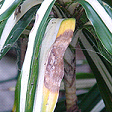 Dracaena deremensis
Dracaena deremensis
Cordyline and Dracaena species may be infected by the leaf spot (Phyllosticta maculicola) which forms small brownish spots that have yellowish margins and has black fruiting bodies that forms coils of spores. These plants are also susceptible to other leaf spots such as (Glomerella cincta) and (Phyllosticta dracaaaenae). Keep foliage dry to avoid infection.
Cynodon dactylon, Pennisetum clandestinum and many other Turf Grasses are susceptible to Helminthosporium Disease.
Daphne species are infected by the leaf spot (Gloeosporium mezerei) and (Marssonina daphnes) both of which form thickish brown spots that are seen on both sides of the leaves. Infected leaves turn yellowish before dieing.
Dendranthema species are infected by many leaf spots such as (Septoria chrysanthemi) which first forms yellowish spots up to 25mm (1in) across that become black. Infected leaves die prematurely and persist on the plant.
Dianthus species may be infected by the leaf spot (Septoria dianthi). It forms light brown rounded spots that have a purplish border. The scattered spots on the lower leaves can also be found on the stems and the spores are dispersed by water from the tiny black fruiting bodies.
Dieffenbachia species are infected by several leaf spot fungi including (Cephalosporium species) and (Myrothecium species).
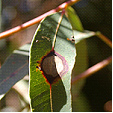 Eucalyptus species
Eucalyptus species
Eucalyptus species are infected by many fungal leaf spots such as (Mycosphaeralla species), (Hendersonia species) and (Monocheatia monochaeta). Generally leaf spots appear on the juvenile or new leaves causing brownish spots that enlarge and may have a purplish halo around the margin. Mature adult leaves are not normally infected and the trees rarely require control measures.
Fern species are infected by the leaf spot, (Alternaria polypodii). This fungus appears as brown circular or oblong spots that congregate along the margins of the pinnae causing the fronds to turn brown and die. It is spread by wind currents from plant to plant and control methods include removing infected fronds and maintaining a drier atmosphere.
Ficus species are infected by various fungal leaf spot including (Pseudocercospora species). Generally the fungal attack forms circular or irregular dark coloured spots on the leaves eventually causing them to fall prematurely.
Ficus elastica is susceptible to many fungal leaf spots including (Alternaria species), (Leptostromella elastica) and (Phyllosticta roberti).
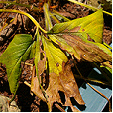
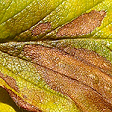 Strawberry
Strawberry
Fragaria x ananassa (Strawberry) is infected by the fungal leaf spot (Mycospharella fragariae). The mature leaf is initially infected with well defined brown spots that that turn light grey with red-purplish margins. As the spots merge they form large brown blotches and the leaf turns yellow then dies. This fungal attack normally occurs on plants in poor health and can be a serious problem early in the season seriously damaging stock.
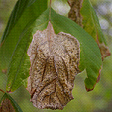 Fraxinus species
Fraxinus species
Fraxinus species are infected by the leaf spot (Gloeosporium aridum) giving the leaf a scorched appearance as large blotches appear from the margin or apex and turn brown with a papery texture. It is more prevalent during rainy periods and infected leaves fall prematurely. Collect and depose of fallen leaves otherwise control is not normally required.
Fuchsia species may be infected by the leaf spot (Septoria species) or ( Cercospora species), both form spots with dead centres and dark margins.
Gladiolus species are infected by Hard Rot or Leaf Spot (Septoria gladioli). On the corms reddish brown circular water soaked spots become large and sunken. These areas dry out and form obvious margins. The leaves may also have these symptoms but is not commonly seen.
Hemerocallis species are infected by several leaf spots including (Cercospora hemerocallis) and (Heterosporium iridis). These may be in the form of black spots or brownish spots that converge killing the leaf. Infected leaves should be removed and burnt.
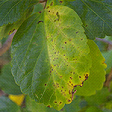 Hibiscus species
Hibiscus species
Hibiscus rosa-sinensis, Hibiscus syriacus and Hibiscus tiliaceus are susceptible to several fungal leaf spots including (Ascochyta abelmoschi), (Cerospora kellermanii) and (Phyllosticta hibiscina). All cause spotting or blotching of the leaf surface; remove and destroy infected parts.
Hydrangea species are infected by four fungal species including (Ascochyta hydrangeae), (Phyllosticta hydrangeae) and (Septoria hydrangeae).
Iris species are infected by several fungal leaf spots including (Alternaria iridicola) and (Macosphaerella species).
Iris species are also infected by the leaf spot (Didymellina macrospore) that forms greyish spots with brown water soaked borders and coalesce on the upper part of the leaf. This casual organism commonly occurs after flowering killing the leaves but will not infect the bulbs. The bulbs become weak over several seasons due to the decreased foliage.
There is also a Bacterial Leaf Spot (Bacterium tardicrescens) that is commonly mistaken as a fungal problem causing translucent spots that coalesce and involve the entire leaf. Normally found on Iris species.
Laburnum anagyroides is infected by the Leaf Spot (Phyllosticta cytisii). The leaf forms light grey spots with no definite margin and mature to brown. The black fruiting bodies appear as dots in the centre of the spot.
Leucanthemum species are infected by the leaf spot (Cerocspora chrysanthemi) and (Septoria leucanthemi).
Magnolia species are susceptible to many species including (Alternaria tenuis), (Mycosphaerella milleri) and (Phyllosticta species). Leaves generally turn brown from the apex or margins turning brown or spots appear on the leaf surface and leaves become yellow before withering and dieing. Normally the make the tree look poorly but have little effect on its growth. Control is not normally required.
Nerium oleander is susceptible to several fungal leaf spots including (Cercospora nerella), (Cercospora repens), (Gloesporium species) and (Phyllosticta nerii). Infected leaves should be removed but generally control is not required.
Nyssa sylvatica is infected by the leaf spot (Mycosphaerella nyssaecola) forming irregular purplish blotches.
Orchids such as Cattleya, Cymbidium, Cypripedium, Dendrobium, Epidendrum, Paphiopedilum, Phalaenopsis and Zygopetalum species are infected by several leaf spots including (Cerospora, Colletotrichum and Phyllosticta species). Normally forming dark or dead, circular or irregular areas on the leaves.
Palms such as Syagrus, Howea, Phoenix, Roystonea and Washingtonia species are infected by Leaf-scab (Graphiola phoeicis).
Palms such as Archontophoenix, Caryota, Chamaedorea, Cocos, Dypsis, Howea, Liculia, Linospadix, Livistona, Phoenix, Ptychosperma, Rhapis, Roystonea, Syagrus, Washingtonia and Wodyetia species are susceptible to several fungal leaf spots including;
(Bipolaris spp.), (Cylindrocladium spp.), (Colletotrichum spp.) and (Pestalotiopsis spp.).
Generally the circular leaf spots are brown and may have a yellow halo such as Palm Ring Spot (Bipolaris incurvata). They vary in size from small to large depending on the species. When a plant is healthy it recovers from attack, but heavy infections can defoliate, causing the collapse of the plant.
Palms are also infected by the Brachybasidium Leaf Spot (Brachybasidium pinangae). This fungus forms angular leaf lesions that produce fruiting bodies on the underside and is commonly found on Archontophoenix species.
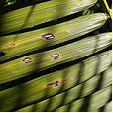
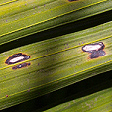 Archontophoenix cunninghamiana
Archontophoenix cunninghamiana
Passiflora species are infected with many types of leaf spot such as (Alternaria passiflorae).
Phoenix species are susceptible to False Smut (Graphiola phoenicis). This fungus forms yellow leaf spots that become hard with a raised with a blackish scab, which produces masses of powdery spores that are thread-like.
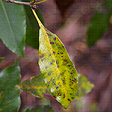
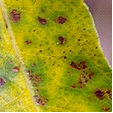 Pittosporum species
Pittosporum species
Pittosporum species are susceptible to the leaf spots (Alternaria tenuissima), (Phyllostica species) and (Cercospora pittospori). Circular or angular dark spots appear on the leaves and are surrounded by necrotic areas that are yellowish. Generally removal of infected leaves is adequate control.
Poa species and other cool season grasses are infected by Winter Fusarium Leaf Disease (Fusarium species), which causes small pale spots that are water soaked to appear on the leaves that turn red-brown. Infected leaves become bleached then wither and die, but the infection will not affect the crown or roots of the plant. It can be identified by pink, cotton-like mycelium and the plant prefers cold wet weather.
Populus species are infected by several fungal leaf spots including (Ciborinia bifrons, Ciborinia confundens), and (Mycosphaerella populicola).
Prunus species are infected by several leaf spots including (Cercospora circumscissa and Septoria ravenelii).
Pseudotsuga menziesii Douglas Fir is infected by the Leaf Cast (Rhabdocline pseudotsugae) Symptoms include the needles becoming yellowish at the apex and extending down the needle and spreading to others during moist spring weather turning them brown. Brownish scorched areas are noticeable on the tree from a distance. Control; is not normally required for mature trees but nursery stock may require spraying with a copper based fungicide.
Psidium guajava (Guava) is infected by (Glomerella cingulate). This fungus courses spots to appear on leaves and mummifies and blackens immature fruit or rots mature fruit. This fungus can devastate a guava crop.
Quercus species are infected by several types of leaf spot including (Cylindrosporium microspilum) and (Marssonina martini). These attacks tend top take place later in the season and normally not detrimental to the tree.
Rhododendron species are infected by a large variety of fungal leaf spots including (Cercospora rhododendri) and (lophodermium melaleucum)
Salix species are infected by several fungal leaf spots including (Ascochyta salicis) and (Septogloeum salicinum).
Senecio species are infected by the fungal leaf spot (Alternaria cinerariae) and (Cercospora species), forming dark rounded or angular spots.
Spiraea species are attacked by the fungal leaf spot (Cylindrosporium filipendulae).
Stenotaphrum secundatum (Buffalo) turf grass is susceptible to Grey Leaf Spot (Pyricularia grisea) in domestic and commercial situations devastating lawns. This fungal disease infects the stems and leaves with small brown lesions that enlarge rapidly forming grey-brown spots that have darker borders or surrounded by yellow chlorotic areas. This infection is commonly found on newly laid turf but will also infect established lawns. It is most prevalent during warm humid periods in soil with a high nitrogen level.
Syringa species are attacked by up to six species of leaf spot including (Cercospora lilacis) and (Phyllostica species).
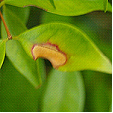 Syzygium species
Syzygium species
Syzygium species are infected by fungal leaf spots but normally control is not required.
Tagetes species are infected by the leaf spot (Septoria tageticola), which starts at the base and moves progressively up through the plant, covering the leaves in grey to black spots.
Trillium species are host to several leaf spots, including (Colletotrichum peckii) (Gloeosporium Trillii) (Heterosporium trillii).
Ulmus species are infected by many fungal leaf spots including (Gnomonia ulmea) and (Cercospora sphaeriaeformis).
Veronica species are infected by the leaf spot (Septoria veronicae). The symptoms include small violet to brown spots appear on the upper surface of the leaf and correspondingly yellowish brown on the underside. The spots converge forming a scorched shot-hole appearance and eventually death of the leaf.
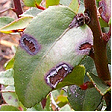 Vaccinium ovatum
Vaccinium ovatum
Vaccinium ovatum is infected by the leaf spot (Rhytisma vaccinii) and (Dothichiza caroliniana).
Vicia species are infected by the leaf spot (Erostrotheca multiformis), which forms greyish spots that enlarge and may defoliate the plant.
Wisteria species are infected by three fungal leaf spots (Phyllostica wisteriae), (Septoria wisteriae) and (Phomatospora wisteriae).
Non-chemical Control
Remove and destroy infected plant material and avoid overhead watering. When planting select infection resistant varieties. Practice crop rotation and add pot ash to the soil to decrease the plants venerability to the disease. Many species of fungus overwinter in fallen leaves, remove and destroy any litter under the plant.
Winter Fusarium Leaf Disease in Turf Grasses can be minimised by aerating the soil, reducing thatch and avoid excessive nitrogen in the soil.
Chemical Control
Protective fungicides such as zineb or copper oxychloride should be sprayed at the first sign of infection and cuttings should be sprayed as they start to grow.
Note
Always read the label for registration details and direction of use prior to application of any chemicals.
DISEASE
NAME
Phytophthora Rot
Phytophthora species
Pathogen Name
A number of Phytophthora species cause these diseases but the most important species in Australia is the cinnamon fungus, Phytophthora cinnamomi. This species is exotic to Australia and probably originated from south east Asia; it has probably been present in Australia for close to 200 years. Phytophthora are fungal-like organisms that are related to some protozoa and algae; they are microscopic and cannot be observed by the naked eye.
Description
There are many types of Phytophthora Rot but generally the disease affects the plant by causing a soft rot of the affected plant part. The most common form of the disease is a rotting of the roots that occurs below ground with no visible symptoms of the disease above ground until the disease starts to cause leaf drop.
Symptoms
The disease is initiated below ground in the soil, usually on the feeder roots of a plant. The pathogen grows through the roots killing cells and eventually causing an extensive root decay. This causes the infected plant to lose vigour and the leaves to yellow and die. Entire branches starting from the top then die, quickly during hot weather or linger for months. The infection occurs on the root hairs causing small and large roots to rot. The symptoms of the disease are often very difficult to differentiate from drought symptoms, mainly because the affected root system prevents the uptake of moisture from the soil. Once the disease has progressed far enough large branches will die causing the typical dieback symptoms.
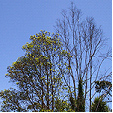
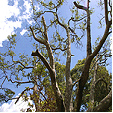
There are a number of other diseases caused by Phytophthora species
Twig Die Back (Phytophthora ilicis) attacks Ilex species causing black leaf spots and black stem cankers.
Phytophthora cactorum is known by several common names depending on which plant is being attacked and they have various symptoms. Plant species are listed below.
Root Rot (Phytophthora richardiae) infects Zantedeschia species causing the leaves to turn yellow, wilt and die. Flowers are deformed if they bloom and the infection can also be seen in the new growth, eventually killing the plant. On inspection the roots show signs of decay.
Stem Rot (Phytophthora cryptogea) infects the roots and stems turning them brown and seeds are also attacked causing decay. It is commonly found on Tagetes erecta and infected plants wilt, collapse and die.
Source and Dispersal
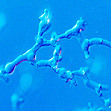 Sporangia
Sporangia 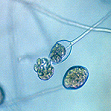 Zoospores
Zoospores 
Image by Dr Brett Summerell
Phytophthora species produce sporangia that contain specialised zoospores that have flagella that allow them to move through the soil moisture small distances. These spores encyst on the root and then penetrate the root. The pathogen also produces chlamydospores, specialised survival spores that allow it to survive in the soil for extended periods of time. The chlamydospores can be transported in soil, even extremely small amounts, allowing the pathogen to be dispersed very easily throughout an area and from one location to another. The zoospores are easily moved in water flowing through soil and so are easily dispersed down slopes. It is not uncommon for the disease to move in fronts down a slope.

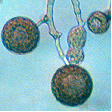 Chlamydospores, specialised survival spores
Chlamydospores, specialised survival spores
Image by Dr Brett Summerell
Favoured Conditions
Phytophthora root rot is favoured by poorly drained soils or in soils that are waterlogged for short periods of time. The disease generally occurs during periods when the temperature is above 16ºC although it has been observed in snow gum country in the Barrington Tops National Park and in southern Tasmania. It also prefers soils that have little organic material.
Affected Plants
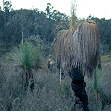
 Xanthorrhoea species
Xanthorrhoea species
Image by Dr Brett Summerell
The host range that is attacked by Phytophthora cinnamomi is enormous and is still not well understood but includes many Australian native plants, Rhododendrons, Acer and Prunus species, conifers, cabbage tree and strawberries. Some Australian plant families that are quite susceptible include species in the Proteaceae, Epacridaceae and Xanthorrhoea species.
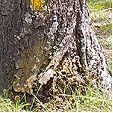 Alphitonia excelsa
Alphitonia excelsa
Alphitonia excelsa can be infected by Phytophthora cinnamomi causing loss of foliage, death of the upper branches and cankers on the trunk.
Cactus such as Cereus species may be infected with Slimy Collar Rot (Phytophthora cactorum) which forms a soft black area at the base of the plant that is water soaked.
Chamaecyparis species may be infected with the Root Rot (Phytophthora lateralis) that attacks roots, trunk, stems and leaves.
Cornus species are infected by Crown Canker (Phytophthora cactorum) and in this case the tree is partially infected initially with one side producing smaller leaves that turn reddish in late summer. The leaves may also shrivel and die prematurely, during dry periods and small and large branches die. After a couple of seasons the tree becomes completely infected with poor top growth and an inconspicuous canker develops at the base of the trunk. Eventually the tree dies.
Erica species are infected by (Phytophthora cinnamomi). The symptoms include foliage turning greyish towards the top, and then the plant wilts then dies with evidence of infection at the base.
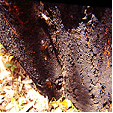 Phytophthora in Eucalyptus species
Phytophthora in Eucalyptus species
Image by B. Sonsie

Image by Dr Brett Summerell
Eucalyptus species are infected by Phytophthora cinnamomi causing rapid die back of the tree with blackened trunk loss or upper growth and is a serious problem for certain species such as Eucalyptus diversicolor (Karri).
Euphorbia pulcherrima is susceptible to Root Rot (Phytophthora and Pythium species). Roots become dark and the rot can extend up the stem. The plant is also susceptible to leaf blight resulting from the same fungal disease.
Hedera species are infected by Phytophthora Blight (Phytophthora palmivora). This fungus causes leaf spots, foliage blight and stem rot.
Palms such as Archontophoenix, Caryota, Chamaedorea, Cocos, Dypsis, Howea, Liculia, Linospadix, Livistona, Phoenix, Ptychosperma, Rhapis, Roystonea, Syagrus, Washingtonia and Wodyetia species are also susceptible to Phytophthora Blight forming large irregular areas on the fronds that become dark and rotten and limited by the veins
Lilium species are infected by Foot Rot (Phytophthora cactorum) which attacking the stems just below the soil level causing the plant to topple and if infection occurs as the leaves are emerging the base of the infected leaves which collapse remain attached to the bulb.
Morinda citrifolia is infected by Phytophthora Blight, black flag disease (Phytophthora species) which causes the foliage to turn black and limp. The fruit and stems are also infected causing them to turn brown-black and whither.
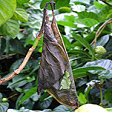
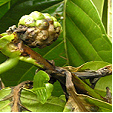 Morinda citrifolia
Morinda citrifolia
Orchids such as Cattleya, Cymbidium, Cypripedium, Dendrobium, Epidendrum, Paphiopedilum, Phalaenopsis and Zygopetalum species are infected by Black Rot (Phytophthora or Pythium species). This causes the leaves, pseudobulbs, rhizomes and roots to form a dark soft rot, normally occurring towards the base of the plant.
Saintpaulia, Dianthus, Gypsophila, Limonium and Anemone species are infected by Root and Crown Rot (Phytophthora nicotianae). This is a fast moving fungus that turns the roots blackish then extends to the crown and petioles causing wet rot of the crown then wilting, eventually killing the plant. When found as Phytophthora Leaf Spot or Blight, angular spots appear with water-soaked margins as in Cordyline and Philodendron species.
Sedum species can be infected by up to three Stem Rot fungi including (Colletotrichum species), (Phytophthora species) and (Pellicularia filamentosa). Commonly occurring in wet soils.
Ulmus and Acer species are also infected by (Phytophthora cactorum) and this is known as Bleeding Canker. This casual disease initially causes cankers in the bark that ooze sap and the sapwood forms reddish lesions with greenish margins. The leaves on affected branches turn yellow, wilt then die and mildly affected trees may survive.
Many species are infected by the Bleeding Canker including Acer platanoides, Acer rubrum, Acer pseudoplatanus, Acer saccharinum, Betula species, Liquidambar styraciflua, Aesculus x carnea, Tilia, Salix and Quercus species.
Non-chemical Control
The most effective control for all Phytophthora diseases is prevention primarily because it is extremely difficult to control Phytophthora diseases after they are established in the plant. As Phytophthora species are most easily transported in infested soil quarantine is an essential component of control of the disease and it is for this reason many areas have hygiene protocols to stop the pathogen being introduced into an area. It is recommended that bush walkers take care not to introduce the pathogen on their boots into un-infested areas and for this reason it is suggested that walking boots be cleaned and preferably sterilised (with 70% methylated spirits) prior to starting a walk.
Cultural techniques such as cultivating the soil regularly with added animal manure and other organic substrates to ensure there is good drainage will also help to minimise the impact of the disease. The plants can be mulched with straw or other organic material taking care that the base of the trunk is left clear. Avoid over watering the soil and observe hygiene in regards to tools, containers or shoes to reduce spreading the infection.
Potting mixes should be pasteurised for 30min at 60ºC to ensure that they are free of the pathogen. It is also very important to grow pots off the ground to prevent the splash of infested mix or water from an infected plant to clean plants.
.
Avoid damaging the bark particularly at ground level and seal any wounds that occur. If cactus or tree species are infected it is possible to cut out the infected area when first seen in order to contain it. Correct tree surgery techniques are required for large trees.
Chemical Control
There are a number of fungicides that are registered for use in the control of these diseases. The most effective chemical control are based on the use of chemicals containing potassium phosphonate. This chemical effectively enhances the defence systems of the plant and has been shown to be most effective in controlling Phytophthora diseases. It is essential that the chemical be applied when the plants is exporting nutrients to the roots, so this is best in the warmer months. The chemical can be applied as a stem injection or a foliar spray, and in some situations as a soil drench. There are specialised stem injecting equipment available for stem injections on larger trees.
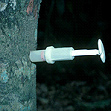
Image by Dr Brett Summerell
Note
Always read the label for registration details and direction of use prior to application of any chemicals.
Amendments by
Dr Brett Summerell
Director Science and Public Programs
Royal Botanic Gardens Trust, Sydney
DISEASE
NAME
Downy Mildew (General)
Various Downy Mildew Species
Description
Generally Downy Mildew may occur as a result of several fungal species, but have simular symptoms. The fungus is normally host specific.
Symptoms
The upper leaf forms yellowish, green or translucent patches that become enlarged and eventually the leaf turns yellowish-brown, wilts and dies. It can extend down the petioles onto the plant causing it to collapse and on the underside of the patches downy spores form, these may be grey to mauve or brown to purplish.
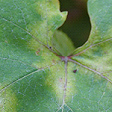
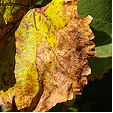
The Downy Mildew (Plasmopara halstedii) forms pale green spots on the upper surface of the leaves with corresponding white felty areas on the underside. The affected leaves contract, turn brown and die; commonly found on Senecio species.
Downy Mildew in Rose (Peronospora sparsa). Angular purplish to dark brown spots or areas develop on the upper leaf surface and under humid conditions, the underside of these areas develop fury fruiting bodies. Young and heavily infected leaves turn brown and fall. The flowers stalks and stems are also attacked with purplish blotches or streaks that may cause them to split. Young growth that is infected dies off and if the flowers are affected in bud blooms become deformed when open.
The spores overwinter on infected plants and fallen leaves and are dispersed by wind infecting new growth during spring.
Downy Mildew in Stocks (Peronospora parasitica). The upper leaf forms yellowish green patches that become enlarged and eventually the leaf becomes yellow, then wilts and dies. It also infects the stems and on the underside of the leaves patches downy grey to mauve-white pustules form where the spores are arranged in rows. This fungus is soil born and commonly dispersed by infected plants.
Source and Dispersal
It is normally found or dispersed on other infected plants. The spores are also spread by wind but are unable to germinate in dry conditions, requiring moisture on the leaf and a humid environment to grow.
Favoured Conditions
It prefers warm humid days with cool nights and spread quickly in closely planted seedlings or plants.
Affected Plants
A wide range of vegetables, annuals, perennials and shrubs are affected. Plants such as stocks and seedlings are at most risk commonly causing the plant to collapse and die.
Aster species are infected by the downy mildew (Basidiophora entospora).
Mathiola incana and Arabis species is infected by (Peronospora parasitica) causing stunting with downy mold on the underside of the leaves. Seedlings are at most risk commonly causing the plants to collapse and die.
Rudbeckia species are infected by the downy mildew (Plasmopara halstedii) causing yellowing of the foliage, wilting and in some cases death of the plant.
Turf Grasses are susceptible to the downy mildew (Scleropthora macrospore), which may not appear downy on the leaves but leaves affected are stunted, thickened or become broad and only under severe cases small yellow patches up to 100mm wide appear in the turf.
Veronica species are infected by the downy mildew (Peronospora grisea). Symptoms include leaves form pale spots on the upper surface while greyish mildew forms correspondingly on the underside.
Viola species ate infected with (Bremiella megasperma) which forms irregular greyish spots on the upper surface and felt-like growth on the underside.
Non-chemical Control
Infected plants must be removed and destroyed and avoid over planting seedbeds. Avoid watering from above or over watering to reduce humidity. When planting out space the plants to allow good air circulation as a dry atmosphere halts or reduces the infection. Select resistant plant species when planting.
Improve drainage and aeration of the soil in affected Turf grasses and avoid overwatering.
Chemical Control
With seedlings drench the soil with a systemic root absorbing fungicide such as furalaxy. Plants can be sprayed with a protectant fungicide such as copper oxychloride or zineb if the weather conditions are favourable for fungal attack. Be certain to thoroughly cover the under side of the leaves.
DISEASE
NAME
Fusarium Wilt (General)
Various Wilt Species
Description
Fusarium wilt is caused by specialised strains of the common soil fungus, Fusarium oxysporum.This fungus is microscopic, and that can live in the soil for many years and primarily attacks plants by entering through the roots. This affects corms, stems and leaves by moving through the water conductive tissue in the plant.
The specialised strains are known as formae speciales (f. sp. or special forms) and each f. sp. has a relatively narrow host range. For example Fusarium oxysporum f. sp. cubense causes Panama wilt of banana, F. oxysporum f.sp. vasinfectum infects cotton and F. oxysporum f. sp. lycopersici attacks tomatoes. Each strain is specific to that narrow host range and will not affect other hosts; this is important as it makes control options involving the planting of other plant species possible.
Symptoms
Generally the plant wilts quickly during hot weather or lacks growth and vigour. Typically the symptoms are often indistinguishable from drought stress. Leaves yellow and wither or stems split open near the base. Individual branches may collapse and die or entire plants perish. One of the distinctive symptoms is a one-sided yellowing and death of a leaf or branch. Corms become rotted with open wounds and affected stems, when split open are yellowish. There are variations in the symptoms depending on the type of plant but generally plants wilt, turn brown and die.

Basal Rot (Fusarium oxysporum) infects Tulipa and Crocus species by turning leaves reddish, which wilt and normally die. It also affects the bulbs by forming few roots and rotting the base, turning them dull white.
This disease also infects cactus such as Cereus species and Zygocactus truncatus causing soft black rot that appears at the tips of the plant then spread rapidly downwards. It is particularly virulent in hot beds, under glass. The infected plants cannot be cured and should be disposed off site.
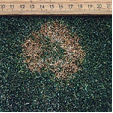 Fusarium Patch, Bent
Fusarium Patch, Bent 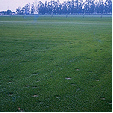 Fusarium Patch, Blue Grass
Fusarium Patch, Blue Grass
Other Fusarium (or related species) diseases
Fusarium Patch (Microdochium nivale formerly known as Fusarium nivale) is also known as Crown or Root Rot and infects warm or cool season Turf Grasses. The fungus infects the roots or rhizome turning them black, sometimes with a pink ting. During hot periods light green to brown patches appear in the turf as the damaged roots are unable to supply water to the leaves. This diseases is not a significant disease in Australia
Minimise irrigation of infected areas to reduce spread of infection as the spores are distributed in water.
Root Rot (Fusarium verticillioides) is a seed born fungus that infects Strelitzia reginae. It also forms a Leaf Spot in Dracaena species where rounded or irregular yellowish to reddish spots with a pail green border form. These are found on immature leaves and heavy infections may rot the crown.
Source and Dispersal
The fungal spores are dispersed by wind from infected plants or parts of plants. It is also dispersed by splashing water or contaminated stock or the movement of soil. With Fusarium wilt of canary island date palms the transfer of infected plant material on chain saws has been shown to be an important way in which the fungus can be transmitted from one tree to another. It is essential in these cases to sterilise the chain and chain bar between trimming the fronds on each tree.
Fusarium oxysporum produces three types of species, macroconidia, microconidia and chlamydospores. The latter two spore types play very important roles in the disease. The microconidia move in the vascular system of the plant and collect at the sieve plates in the xylem of plant. Here they germinate and grow and eventually block the sieve plate thus stopping the flow of water in the plant. The chlamydospores are specialised survival spores that persist in roots and in the soil for very long periods of time, thus allowing the fungus to survive periods when there are no susceptible plants present.
Favoured Conditions
The fungus prefers warm humid climates and is commonly seen in coastal regions and may continue living in soil for many years.
Affected Plants
Many species are infected including tomatoes, carnation, cucurbits and freesia. Die Back (Fusarium solani var. martii) causes damage to the branches of Ilex species. Fusarium also attacks palm species such as Phoenix causing wilt.
Albizia and Alternantera species are infected by the wilt (Fusarium oxysporum var. periciosum ) that causes the leaves to wilt, shrivel and die. This infection also extends to the branches and eventually may kill the tree.
Callistephus species are attacked by the wilt (Fusarium oxysporum f. sp. callistephi) which infects the vascular bundles turning brown, particularly on one side of the stem causing the plant to become stunted, eventually dieing.
Dendranthema and Thymus species are susceptible to the Stem Rot (Fusarium species) and (Pellicularia filamentosa) which rots the base of the stem.
Dianthus species are infected by Bud Drop (Fusarium poae). This fungus rots flower buds prior to opening and infected flowers open with distorted, unattractive petals. The control of thrips is essential. Dianthus species are also infected by Wilt (Fusarium oxysporum) that causes yellowing and wilting of the lower leaves, normally on one side. The infection causes stems to rot with vascular discolouration.
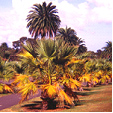
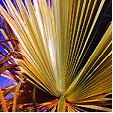 Fusarium Wilt Image by B. Sonsie
Fusarium Wilt Image by B. Sonsie
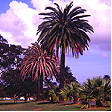
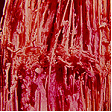 Image by Dr Brett Summerell
Image by Dr Brett Summerell
The only palms susceptible to Fusarium wilt are Phoenix species, especially Phoenix canariensis and juvenile Washingtonia filifera. Initially the leaflets turn yellowish then brown, on mature fronds causing them to die. Eventually only tufts of new growth remain the plant. As the infection continues the plant collapses and dies.
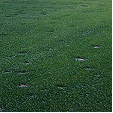 Fusarium Patch
Fusarium Patch
Turf grasses are infected by Fusarium Patch (Microdochium nivale). Plants include; Digitaria didactyla (Blue Couch), Cynodon species (Couch), Eremochioa ophiuroides (Centipede Grass), Festuca species, Paspalum vaginatum (Salt Water Couch), Pennisetum clandestinum (Kikuyu), Poa species (Bluegrass), Stenotaphrum secundatum (Buffalo) and Zoysia species. Generally the fungus produces small dead circular patches in the lawn.
Non-chemical Control
Fusarium diseases are extremely difficult diseases to control primarily because of a lack of a chemical control option and because the fungus is able to persist in soil for long periods of time. Crop rotation to non susceptible plants is advised and consequently it will be important to have the disease accurately diagnosed to ensure the identity of the pathogen and the possible rotation options.
Remove and destroy any infected plants. In the case of large trees or palms, it will be necessary to remove the infected plant, this not only means cutting down the above ground parts, but also removing the roots of the plant. These will then need to be removed and destroyed.
Fusarium Patch can be minimised by reducing thatch and aerating the soil regularly or improving the drainage.
Chemical Control
There are no effective chemical control options currently available for plant diseases caused by Fusarium species.
Note
Always read the label for registration details and direction of use prior to application of any chemicals.
Amendments by
Dr Brett Summerell
Director Science and Public Programs
Royal Botanic Gardens Trust, Sydney
DISEASE
NAME
Powdery Mildew
Various Powdery Mildew Species
Description
Powdery mildew covers arrange of fungal infections most with simular characteristics of white powdery areas appearing on the leaves and flowers.
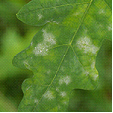
 White powdery area
White powdery area 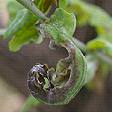
Symptoms
Powdery mildew (Oidium species) affects the following five plant groups with slightly different characteristics.
Cucurbits firstly form white spots on the underside of the leaves. Under optimum conditions the fungus spreads to the upper surface covering the entire leaf causing it to die. It may also extend to the stems slowing the growth of the plant and may reduce the size of the fruit.
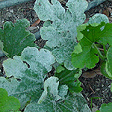
Grape leaves, flowers and fruit are attacked with the appearance of greyish-white powdery spots. Infected flowers set poor quality fruit and infected fruit splits open and dries out.
Pawpaw leaves become infected on the underside at first then spreading covering the entire leaf. The fruit forms irregular light grey spotted areas that damages the surface and under the surface causing the fruit to misshapen and reducing its market value.
Rose leaf and buds are covered in a fine white powdery coating and in severe cases it extends to the stems. When young leaves are infected they become distorted and older leaves develop blackened areas. Infected flower buds may fail to open and opened blooms may be discoloured or distorted.
Strawberries show different signs of infection with the leaf margins first rolling upwards then developing purplish irregular blotches along the veins. The infected flowers may fail to set fruit and if fruit is produced it is small, hard fails to ripen. Semi mature fruit that is infected has dull appearance and may form cracks or split open.
The Powdery Mildew (Sphaerotheca lanestris) infects leaves and twigs. The under side if the leaf firstly has a white mealy growth that matures to felt-like brown mycelium that can cover the entire leaf, and the twig tips. It is only one of the many types that infect Quercus species.
Source and Dispersal
The spores overwinter in fallen leaves, dormant buds, seed and infested plants. It is dispersed by wind.
Favoured Conditions
Generally it prefers warm humid conditions, but failing to germinate when it is raining. The fungus that attacks Pawpaw prefers cooler conditions disappearing in the warmer months.
Affected Plants
There are many plant species ornamental trees and shrubs that are attacked by Oidium species including; Roses, African Violets, Cucurbits, Grapes, Pawpaw, Strawberries, Hydrangeas, Ajugas, Antirrhinum, Oaks and Photinias.
Acer species are infected by the powdery mildews (Uncinula circinata) and (Phyllactinia corylea) but are not normally serious.
Aesculus species are infected by the powdery mildew (Uncinula flexuosa) which forms a white mold on the underside of the leaves.
Arenaria,Cuphea, Erica and Eschscholtzia species are infected by the powdery mildew (Erysiphe polygoni). This fungus is greyish or white and covers leaves or young shoots. Heavenly infected leaves turn brown and fall from the plant. The plant eventually dies.
Aster species are infected with the powdery mildew (Erysiphe cichoracearum) which is more prevalent on the lower part of the plant.
Ceanothus, Corylus, Platanus, Syringa and Weigela species are infected by the powdery mildew (Microsphaera alni) particularly London Plane. The mycelium forms a felt-like cover on the leaves.
Celtis species are susceptible to the powdery mildew (Uncinula parvula) and (Uncinula polychaete). This fungal problem can affect either side of the leaf, which can have spots or be completely coved in mildew. The fruiting bodies appear on the opposite side of the mildew.
Cornus species leaves are infected by the powdery mildew (Microsphaera alni) and (Phyllactinia corylea), covering the leaves in a whitish fungus.
Dahlia species are infected by the powdery mildew (Erysiphe cichoracearum) that forms white powdery areas on the leaf surface.
Lagerstroemia species are infected by the powdery mildew (Uncinula Australiana) that forms white powdery growth on the leaves and may also distort the infected foliage.
Populus and Salix species are infected by a white powdery mildew (Uncinula salicis) that produces black fruiting bodies with a curled tip, but is not normally a major problem.
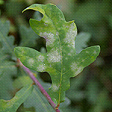
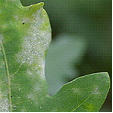 Quercus robur
Quercus robur
Quercus species are susceptible to several powdery mildew fungi including (Sphaerotheca lanestris), (Erysiph trina) and (Phyllactinia corylea). Generally white mealy growth appears on the leaves, normally on the underside turning the infected areas brown and then the leaf dies. The infection may spread to the twig tips causing dieback. Control may be difficult and unwarranted on large trees but nursery stock may be sprayed with a fungicide during susceptible periods.
Rosa species are also infected by the powdery mildew (Sphaerotheca pannosa).
Rudbeckia and Senecio species are covered in white fungus (Erysiphe cichoracearum) which infects leaves, flowers and stems. This results in the plant becoming stunted.
Senecio species are infected by the powdery mildew (Sphaerotheca fuliginea) which forms circular white powdery areas on the leaves.
Spiraea species are infected by the Powdery Mildew (Microsphaera alni) and (Podosphaera oxyacanthae).
Ulmus and Rhododendron (Azalea) species are also infected by (Microsphaera alni). Circular patches of white powdery growth appear on the leaves.
Veronica species are sometimes infected by the powdery mildew (Sphaerotheca humili) causing a white coating to appear on the leaves. Not normally a major problem.
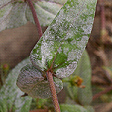
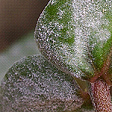
Zinnia elegans are commonly infected by the powdery mildew (Erysiphe cichororacearum), which appears on both sides of the leaves as a greyish powdery cover and may be transmitted by seed.
Non-chemical Control
Choose less susceptible species and when planting space the plants to allow good air circulation. Avoid overwatering and try to keep the foliage dry. Affected plants may be dusted with powdered sulphur or sprayed with a milk mixture to discourage mildew. Vegetables that are infected with mildew should be removed and replaced with new young plants, as they are more resistant to infection.
Chemical Control
Prenatitive spraying during warm humid conditions using a suitable fungicide such as wettable sulphur, bitertanol, carbendazim, fenarimol and triforine helps control the problem.
Note
Always read the label for registration details and direction of use prior to application of any chemicals.
Average Lowest Temperature : -3º C 27º F
USDA : 9, 10
This USDA (United States Department of Agriculture) hardiness zone chart can be used to indicate a plant’s ability to withstand average minimum temperatures. However, other factors such as soil type, pH, and moisture, drainage, humidity and exposure to sun and wind will also have a direct effect on your plant’s survival. Use this chart only as a guide, always keep the other factors in mind when deciding where, when and what to plant.
A plant's individual USDA zone can be found in the Plant Overview.
Climate Description
Warm Temperate
This zone has the majority of rain during winter in the west and summer in the east with high humidity. Summer temperatures may peak at 40ºC (104ºF).
Frost and drought mainly occur inland and coastal wind is normally accompanied with rain.
Plant growth
Wide range of native and exotic plants grow well.
| Dictionary | Growth Habit |
| Leaf Type | Botanic Flower Description |
| Leaf Shape | Flower Inflorescence |
| Leaf Arrangement | Fruit Type |
| Leaf Margin | Bark Type |
| Leaf Apex And Bases | Flower Description |